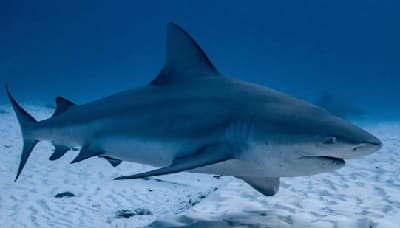Home › Sea Wildlife › Marine › Vertebrates › Sharks › Bull Shark › Reproduction
How Do Bull Sharks Reproduce and When?
This guide contains interesting facts about the bull shark breeding season, how Carcharhinus leucas mate, and the gestation period during pregnancy.
Typically, reproduction begins when the summer starts to end. Males and females initiate the mating season in the shallow, brackish water of river mouths.
Bull Shark Life Cycle from Pups to Maturity
Being mostly pelagic, bull sharks roam the seas and oceans completely alone for most of the year.
But, once they are ready to breed, they abandon the solitary behaviour to commence the mating season.
Here's the thing:
The courtship rituals for bull sharks begin as summer turns to autumn.
They mate in shallow bays or areas where fresh water meets sea water (e.g. estuaries).
Carcharhinus leucas species are viviparous marine animals, meaning they will give birth to baby bull sharks (called pups) that are alive, fully formed, and able to swim freely in the water column.
Often, litters consist of a single pup. But, some females give birth to several pups at a time (up to a dozen in some cases).
Pro Tip: Another section contains even more bull sharks facts and information about Carcharhinus leucas species, including how the Zambezi shark got its name.
Procreation and Fertilisation
The limited scientific documentation and observation about the bull shark's reproductive process makes it difficult to catalog their exact mating behaviours.
For example, some facts about the courting characteristics still remain inconclusive. Even so, we understand that a matured female needs to reach at least two (2) metres in length and about eighteen (18) years old before she can produce eggs that will fertilise 'successfully'.
In spite of that:
By comparison, male bull sharks reach their sexual maturity once they reach the age of fourteen (14). Speculation also suggests that males are somewhat violent during the mating ritual.
They often display "bullying" behaviour leading up to procreation. In fact, it's not uncommon for a male to bite the female's tail - with aggression.
Hence, the mating habits often cause serious scratch injuries, until the female unwillingly submits and rolls upside down for copulation into a single functional ovary on the right side of her body.
Bull Shark Gestation Period
The average female will be gestating (the period of pregnancy) for a time span of ten (10) to twelve (12) months before she will bear live young.
During gestation, the pups will be growing inside the mother's body and receiving oxygen and nutrients from the placental connection to her bloodstream.
 Newborn offspring will be fully developed after birth and they may already be more than one metre long (4 feet) and weigh seven (7) kilograms (15 pounds).
Newborn offspring will be fully developed after birth and they may already be more than one metre long (4 feet) and weigh seven (7) kilograms (15 pounds).
Bull shark pups measure around seventy (70) centimetres (almost 30 inches) and they separate immediately from each other and away from the mother.
They are ready to look after themselves and it usually takes the youngsters ten (10) years of growth to reach full sexual maturity.
In fact, the entire bull shark life cycle can take twenty (20) years for this species to reach full maturity. During this time they will face many challenges.
Predatory Threats for Young Bull Sharks
Coastal lagoons and shallow river mouths are the common nursery habitats for small pups. So, they are vulnerable to certain predators.
Unlike most of the shark species (cartilaginous fishes), adult bull sharks do not rear their young. But, after leaving them in flat protected nurseries, their chances of survival will be good once they learn how to hunt.
Even though large predators stay away from flat shallow regions, the slow growing bull shark pups will be exposed to larger sharks looking for easy prey.
Related Information and Help Guides
- Fun and Interesting Facts about Bull Sharks
- Bull Shark Range Map and Territorial Habitat
- Horn Shark Behaviour and Characteristics
Note: The short video [1:43 seconds] presented by National Geographic contains footage of the bull shark (Carcharhinus leucas) and shows the identifying characteristics that set them apart from other sharks.